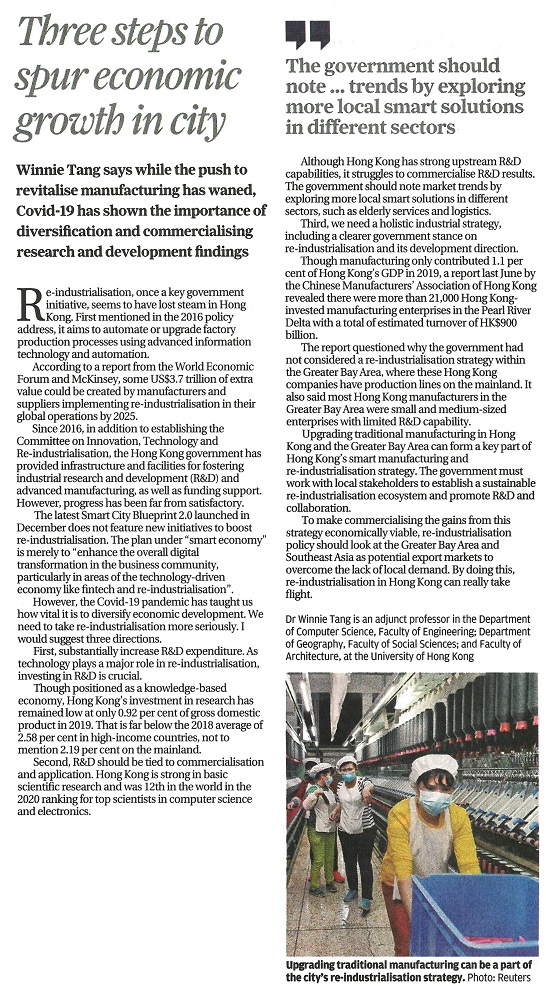網上版請按此

Three steps to spur economic growth in city
Re-industrialisation, once a key government initiative, seems to have lost steam in Hong Kong. First mentioned in the 2016 policy address, it aims to automate or upgrade factory production processes using advanced information technology and automation.
According to a report from the World Economic Forum and McKinsey, some US$3.7 trillion of extra value could be created by manufacturers and suppliers implementing re-industrialisation in their global operations by 2025.
Since 2016, in addition to establishing the Committee on Innovation, Technology and Re-industrialisation, the Hong Kong government has provided infrastructure and facilities for fostering industrial research and development (R&D) and advanced manufacturing, as well as funding support, such as the HK$2 billion (US$258 million) Re-industrialisation Funding Scheme under the Innovation and Technology Fund.
However, progress has been far from satisfactory. According to a 2020 report from the Legislative Council Secretariat Research Office, "there has been a marginal growth of the economic contribution of the innovation and technology industry, from the static rate of 0.7 per cent in the previous nine years to 0.8 per cent of GDP in 2018."
The latest Smart City Blueprint 2.0 launched in December does not feature new initiatives to boost re-industrialisation. The plan under "smart economy" is merely to "enhance the overall digital transformation in the business community, particularly in areas of the technology-driven economy like fintech and re-industrialisation".
However, the Covid-19 pandemic has taught us how vital it is to diversify economic development. We need to take re-industrialisation more seriously. I would suggest three directions.
First, substantially increase R&D expenditure. As technology plays a major role in re-industrialisation, investing in R&D is crucial.
Though positioned as a knowledge-based economy, Hong Kong's investment in research has remained low at only 0.92 per cent of gross domestic product in 2019. That is far below the 2018 average of 2.58 per cent in high-income countries, not to mention 4.81 per cent in South Korea and 2.19 in China. We need to substantially increase R&D expenditure to catch up and stay competitive.
Second, R&D should be tied to commercialisation and application. Hong Kong is strong in basic scientific research and was 12th in the world in the 2020 ranking for top scientists in computer science and electronics.
Although Hong Kong has strong upstream R&D capabilities, it struggles to commercialise R&D results. The government should note market trends by exploring more local smart solutions in different sectors, such as elderly services and logistics.
Third, we need a holistic industrial strategy, including a clearer government stance on the definition of re-industrialisation and its development direction.
Though manufacturing only contributed 1.1 per cent of Hong Kong's GDP in 2019, a report last June by the Chinese Manufacturers' Association of Hong Kong revealed there were more than 21,000 Hong Kong-invested manufacturing enterprises in the Pearl River Delta with a total of estimated turnover of HK$900 billion. More than 90 per cent of them were headquartered in Hong Kong.
The report questioned why the government had not considered a re-industrialisation strategy within the Greater Bay Area, where these Hong Kong companies have production lines on the mainland. It also said most Hong Kong manufacturers in the Greater Bay Area were small and medium-sized enterprises with limited R&D capability.
This aligns with research indicating technology adoption in production can be slow even after successful pilot schemes as many lack the resources or knowledge to capitalise on innovation. The Chinese Manufacturers' Association report suggested developing high-value industrial technology under the government's re-industrialisation initiative could help existing industries become more competitive.
Traditional sectors can still be a target market for applying R&D results. For example, advanced machinery and robotics can be used in garments, electronics and food processing, all major sectors in the Greater Bay Area.
Upgrading traditional manufacturing in Hong Kong and the Greater Bay Area can form a key part of Hong Kong's smart manufacturing and re-industrialisation strategy. The government must work with local stakeholders to establish a sustainable re-industrialisation ecosystem and promote R&D and collaboration.
To make commercialising the gains from this strategy economically viable, re-industrialisation policy should look at the Greater Bay Area and Southeast Asia as potential export markets to overcome the lack of local demand. By doing this, re-industrialisation in Hong Kong can really take flight.
Dr. Winnie Tang
Adjunct Professor, Department of Computer Science, Faculty of Engineering; Department of Geography, Faculty of Social Sciences; and Faculty of Architecture, The University of Hong Kong